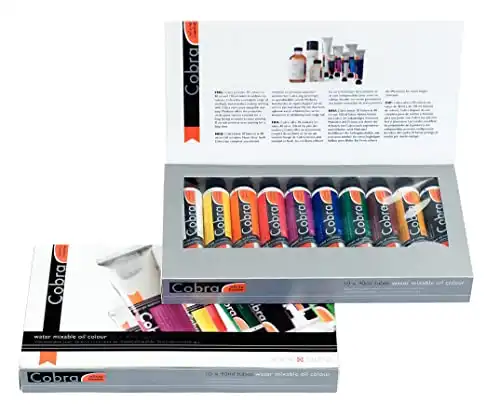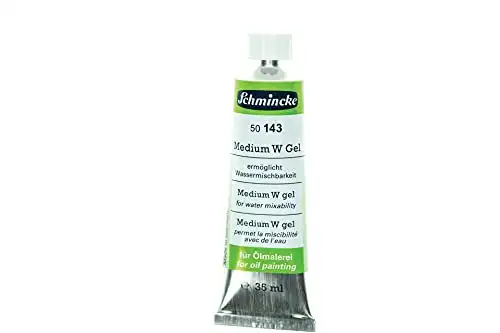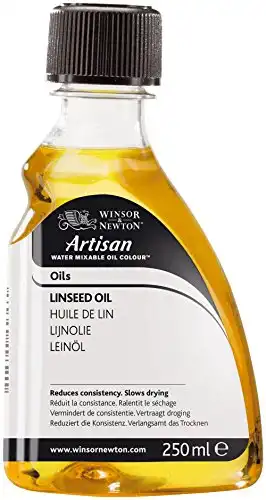Water mixable oils are a relatively recent invention. They are a special type of oil paint that you can clean up with soap and water. You can also thin them down with water instead of paint thinner.
So since you can thin them with water, you may be wondering if you mix them with water based painting mediums such as acrylics or gouache. Another popular question is whether you can mix water mixable oils with regular oils, linseed oil, or other paintings mediums.
I address all of these questions in this post.
One thing you may be surprised to learn is there’s a medium that you can add to any brand of oil paints to turn them into water mixable oils.
That is something that would be great if you have a favorite brand of oils that don’t offer a water mixable version. It’s also useful if you want you use up the regular oils that you have on hand.
Water mixable oils clean up with soap and water. You can also use water to thin the paint out for the first layer of the painting. No solvents are required!
Table of Contents
Do Water Mixable Oils Contain Water?
It’s easy to assume that water mixable oils are some sort of water based painting medium. And then you may wonder if you can mix them with acrylics in the same painting.
Do water mixable oils contain water? No, they don’t contain any water at all. They’re essentially regular oil paint with an extra ingredient that allows you to clean them up with soap and water.
The manufacturers don’t specify what that extra ingredient is but it’s probably an emulsifier of some sort.
Other than that, they have the same characteristics as regular oils. They dry slowly and you can create smooth blending effects and soft edges like you can with traditional oil paints.
When I was first testing them out, I found that it feels weird to add water to oil paints. I was also wondering about how they dry when you have oil and water in the same painting.
From what I’ve read from the manufacturers, what happens is the water evaporates first and then what you have left is regular oil paint. Once the water evaporates, the oil paint dries as it normally would.
This can take a lot longer than acrylics, which is what some artists are looking for–more time for blending.
Can You Mix Water Mixable Oils With Acrylics?
Can you mix water mixable oils with acrylics? Of the 7 brand of water mixable oils I researched, 3 say yes, 2 don’t address it, and rest don’t recommended it because the long term results are unknown. So the answer is that it’s possible, but you should consider it to be an experimental technique.
Below is a table of the 7 brands of water mixable oils that I researched. I list each brand and whether or not they recommend mixing their water mixable oils with acrylics. For some of the brands, I couldn’t find any information.
| Brand of WMOs | What you can mix it with |
|---|---|
| Holbein Duo Aqua | Gouache, watercolor, acrylic |
| Lukas Berlin | Acrylics, Gouache |
| Weber wOil | Acrylics |
| Royal Talens Cobra | Possible but not recommended |
| Winsor & Newton Artisan | Not recommended |
| Grumbacher Max | No Information |
| Daniel Smith WMO | No Information |
What’s Wrong With Mixing Water Mixable Oils and Acrylics?
Painting oils over acrylics is something that artists often do, but that’s completely different than mixing the two paints together while they’re wet.
As I’ve already mentioned, water mixable oils don’t contain water so they’re not water based.
So what’s the concern about mixing water mixable oils with acrylics? It has to do with the differences between the two different binders. Oil paints use an oil for a binder and acrylics use an acrylic emulsion which is a type of plastic.
I think the catch is you’re introducing an acrylic plastic emulsion into the oil paint. So you have oil and a plastic binder in the same painting.
These different painting mediums dry at different rates which could be a problem. You also will probably end up mixing the oil and acrylics together in different ratios throughout the painting.
I think this is where the concern comes into play. You have varying amounts of acrylics and oils in the same painting, drying at different rates.
That’s why mixing water mixable oils with acrylics is stills considered experimental.
I found this post on the wet canvas forum which was started by Kyle from Royal Talens.
They quote Michael Skalka from the National Gallery Conservation Department as saying he always thought this was a bad idea (combining water mixable oils with acrylics).
The people from Royal Talens go on to say that no one knows what will happen to the oil acrylic combination over time.
Can You Mix Water Mixable Oils With Watercolor or Gouache
Three of the manufacturers of water mixable oils say that you can mix them with watercolor and gouache. Some advise against it, and the rest make no mention of it. So you can mix them, it’s just a matter of whether there will be any long term conservation issues.
According to Holbein you can mix their water mixable oils with other mediums.
In their section where they give tips on working with it they say that adding water will help with mixing these with other mediums.
Lukas states on their website that you can mix their water mixable oils with acrylics, and gouache colors.
They state that adding water to water mixable oils will allow you to create watercolor like effects. You may want to try these techniques instead of introducing watercolors into water mixable oils.
Winsor & Newton doesn’t recommend mixing their Artisan Water mixable oils with any of their other line of colors. Their explanation is that doing so you may end up violating the fat over lean principle (link to W&N website).
I think Winsor & Newton is making the same point that I did earlier in this post. That when you add mix another medium with water mixable oils, it’s likely you’re going to apply them in different ratios.
So you’ll end up with parts of the painting where you have a slower drying layer on top of a faster drying layer.
I’m not sure if the differences of opinion comes from the fact that these paints are made differently. Another explanation is some manufacturers are more conservative about what they recommend.
This is understandable because there’s no long term data on how combining these mediums will hold up over time.
Can You Mix Water Mixable Oils With Regular Oils?
If you’re making the switch to water mixable oils and have some regular oils in your studio, you might be thinking about mixing them together.
Can you mix water mixable oils with regular oils? Yes, most manufacturers say that you can mix them together but only up to about 20%-30%. Anything more than that and you will begin to lose the water mixable qualities.
So if you push the limits by adding a large proportion of regular oils to your water mixable oils, you will find that they don’t behave normally.
The brushes will be more difficult to clean. You may have to resort to using paint thinner to clean them.
Having to use solvents defeats the purpose of using water mixable oils.
Also, you might not be able to thin the paint with water. It would bead up and not mix very well.
In my opinion, it makes more sense to just use water mixable oils exclusively so you can retain the water mixable qualities.
It will also make things simpler because you won’t have to keep track of how much traditional oil you mixed into your water soluble oils.
Can You Mix Water With Regular Oil Paint?
No, you can’t mix oil paint with water. Oil and water don’t mix, so the water would bead up and not mix with the paint very well. The only exception are water mixable oils. There’s also a medium that will turn regular oils into water mixable oils.
If you’re thinking about adding water to oil paint, then I would assume that you want to thin the paint out.
The way that you would thin out traditional oils is to use a thinner or a painting medium for this purpose.
One exception is if you first add a medium to the regular oils paint that makes it water mixable. I discuss this in the next section.
How to Turn Regular Oils in to Water Mixable Oils
Wouldn’t it be great if you can take your favorite brand of oils and turn them into water mixable oils? Well, it turns out that you can.
Schmincke Medium W is a medium that you can add to any oil paint to make it water mixable.
This medium will allow you can turn any oil paint into water mixable oils.
The directions say to add one part of the medium to two parts of your favorite brand of oil paint. You can then use water to thin the paint and clean your brushes.
If you prefer thicker oil paint Schmincke makes Medium W in a gel. It works the same, but it’s much thicker than the medium. So if you prefer that your paints remain thick then you can use this gel instead and retain the consistency of the paint.
Mix this gel into regular oil paint to make it water mixable oil.
These mediums and gels allow you to clean your tools and bushes without having to use solvents.
Schmincke says that it’s odorless but a few people said it has a slight odor. However, it should be much more subtle than the odor that solvents have.
One thing to keep in mind is that adding medium to your paint will make it slightly more transparent. It might not make a noticeable difference, especially if they are professional grade oils.
That’s because professional oils usually have a higher pigment load.
If this becomes an issue then you may want you look into a brand of water mixable oils. I like the cobra brand.
Can You Mix Linseed Oil With Water Mixable Oils?
There are water mixable linseed oils available from different manufacturers. You can add them to water mixable oils without a problem. As for regular linseed oil, you can add a small amount to your water mixable oils.
The best option is to use the water mixable linseed oil so that you can clean your tools and brushes with water. And it makes things easier than using regular linseed oil.
Add this linseed oil to your water mixable oils to improve flow, increase gloss, and slow the drying times. Best of all you can clean it from your brushes with soap and water!
If you use regular linseed oil, there’s a chance that you might add too much and then you’ll have to resort to using solvents to clean your brushes.
When that happens you will also lose lose the water mixable qualities. You’ll notice this when you try to thin the paint with water, it won’t mix in properly. This is similar to when you add too much regular oil paint to water mixable oils.
Conclusion
All of these questions make me wonder why artists want to combine so many different painting products. I think part of it that maybe you want you use up old colors that you have laying around. Or maybe there’s a color that you have in regular oils that the brand of water mixable oils don’t have.
Other than that I don’t see the benefit. There’s more of a benefit if you keep things simple.
Using one type of painting throughout the painting process is one way to accomplish this. I don’t like making the painting process more complicated than it has to be.
Trying to combine acrylics and water mixable oils in the same painting complicates then entire process. For one, you would have to keep colors in stock for two brands of paint.
If you like the fast drying nature of acrylics you can add fast dry medium to your water mixable oils to make them dry faster.
Another thing is that you can add water to water mixable oils to get then washes of color. In a way this is similar to how acrylics behave.
That’s what I liked about acrylics, you can achieve thin washes of color are thick layers without having to switch paints.
You can kind of get the same effect with water mixable oils. Thin them with water to for the first layer to block in the basic shapes.
However, additional layers should contain more oil so that it follows the fat over lean principle.
It’s interesting how far paints have changed over the past few decades. You can now clean up oil paints with water. There are water mixable mediums that you can add to the paint just like regular oil paint.
This is great news for artists who like painting with oils but can’t tolerate he solvents. I like the cobra water mixable oils from royal talens. They don’t seem to have much smell at all.
Cleaning my brushes is easier than ever. I just clean off with warm soap and water just like you would with acrylics.
I get to avoid the smell of solvents. That saves me money and I don’t have to store these chemicals in my home.
Give water mixable oils a try, I think you may be surprised at how well they work.







